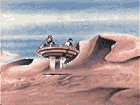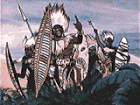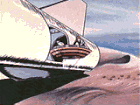Jonny Quest
Template:Infobox television 2 Jonny Quest (often referred to as The Adventures of Jonny Quest) was a science fiction American animated television series produced by Hanna-Barbera Productions, and created and designed by comic book artist Doug Wildey, about the adventures of a young boy who accompanies his father on extraordinary adventures. The first of several Hanna-Barbera action-based adventure shows, which would later include Space Ghost, The Herculoids, and Birdman and the Galaxy Trio, Jonny Quest ran on ABC in prime time for one season in 1964 - 1965. After spending two decades in reruns, new episodes were produced for syndication in 1986, and two telefilms and a spin-off series (The Real Adventures of Jonny Quest) later revived the characters for the 1990s.
Original 1964-1965 show
Inspiration
Jonny Quest was designed to evoke both the drama of a dramatic adventure radio serial, and the fantasy of a comic book. Unlike earlier H-B programs, violence was not shied away from, but used to add suspense and impact to the show.
The show’s most notable inspiration comes from the classic old-time radio serial Jack Armstrong. In fact, Hanna-Barbera had originally intended to produce an animated adaptation of Jack Armstrong. Hiring noted comic book artist Doug Wildey, H-B began negotiations with Jack Armstrong's copyright owners, and produced a test Jack Armstrong pilot in 1962. Negotiations fell through, and the Jack Armstrong project was retooled into Jonny Quest, an original series based on a similar idea. Scenes from the Jack Armstrong test film were incorporated into the Jonny Quest closing credits montage: they are the scenes of the red-haired boy and his father escaping from the African natives using a hovercraft.
Other acknowledged inspirations for Jonny Quest come from Milton Caniff’s adventure comic strip Terry and the Pirates (which was also a popular radio show), and the James Bond film Dr. No, which had inspired Joseph Barbera to develop an action-adventure program.
However, critics have also noted a very strong resemblance between Jonny Quest and Rick Brant, teen star of a boys-oriented adventure series published by Grossett & Dunlap from the 1940s to the 1960s (in the genre of The Hardy Boys, Tom Swift, Jr., and others.). The Rick Brant SCIENCE Adventures featured a likable teen hero, his science-researcher father, a tiny island installation, mystery stories oriented around science and technology, and such regular characters as a Race Bannon-like secret agent and a young Hadji-like pal, Chadha, from Calcutta. Nevertheless, the similarity between Rick Brant and Jonny Quest has never been officially acknowledged by Hanna-Barbera.
Characters, voice cast, and premise
Jonny Quest is a ten- or eleven-year-old boy (there is some question about his exact age; it is never stated in any of the show's episodes), the son of Dr. Benton Quest, "one of the three top scientists in the world," and apparently something of a Renaissance man; his scientific and technical know-how spans many fields. Mrs. Quest is presummed dead, possibly the victim of a plot against Dr. Quest, and mentioned only in the pilot episode (Mystery of the Lizard Men). Government fears that Jonny could "fall into the wrong hands," resulted in the assignment of a bodyguard, Roger "Race" Bannon, from "Intelligence One". Bannon guards and tutors Jonny and Dr. Quest's adopted second son, Hadji (his original last name is never mentioned), an eleven-year-old Indian boy (his age was stated in one of the show's episodes, Pirates from Below) who is seldom seen without his bejewelled turban and Nehru jacket. The Quests have a compound in the Florida Keys (the particular island is named Palm Key), but their adventures take them all over the world. Jonny's pet, a small white french bulldog named Bandit, often provides comic relief although at least once (Skull and Double Crossbones) he was instrumental in foiling the bad guys.
Dr. Quest travels the globe studying scientific mysteries, which get him into scrapes with foes that range from espionage robots and electrical monsters to Egyptian mummies. Although most menaces were unique to the episode, one recurring nemesis is known as Dr. Zin, an Asian mastermind. Race Bannon's mysterious old flame, Jezebel Jade, also occasionally appears.

Tim Matheson performed the voice of Jonny. Mike Road was "Race" Bannon, Danny Bravo was Hadji, and Dr. Benton Quest was voiced by John Stephenson for five episodes, and by Don Messick for the remainder of the shows. Messick also provided Bandit's vocal effects, which were combined with an archived clip of an actual dog's barking. The voices of Dr. Zin and other assorted characters were done by Vic Perrin, who is best remembered as the "Control Voice" for the original The Outer Limits television series.
The memorable theme music for the 1960s series, a percussion-heavy big band "spy jazz" piece with no lyrics, was written by Hoyt Curtin. The character Hadji was noted as the first major non-white character to be presented as an equal sympathetic participant in the stories in American television.
Jonny Quest first aired on September 18, 1964 on the ABC network, and was an almost instant success, both critically and ratings-wise. It was canceled after one season, not because of poor ratings, but because each episode of the show went over budget. Notably more realistic and detailed than previous Hanna-Barbera prime time programs such as The Flintstones and The Jetsons, Jonny Quest required an attention to detail that ABC was unable to afford. Since its initial run on ABC, it has been shown in re-runs on NBC and CBS as well as various incarnations on cable, including Cartoon Network’s Boomerang channel. The "classic" series was released to DVD as Jonny Quest: The Complete First Season in 2004. It should be noted, however, that this DVD set contained some minor editing of the episode "Pursuit of the Poho," as well as use of the same set of syndicated credits for all episodes.
Comic Books
A Jonny Quest comic book (a retelling of the first TV episode, Mystery of the Lizard Men) was published by Gold Key Comics in 1964. Comico began publication of a Jonny Quest series in 1986, with the first issue featuring Doug Wildey's artwork. The series ran for 31 issues, with 2 specials and 3 "classic" issues drawn by Wildey retelling three of the Quest TV episodes ("Shadow of the Condor", "Calcutta Adventure", and "Werewolf of the Timberland"). The series attracted Doug Wildey for several more covers, as well as Steve Rude, Dave Stevens and other famous artists. The series also spun-off a 3-issue series named Jezebel Jade which told the story of Jade's relationship and adventures with Race Bannon. Joe Kelly, who wrote a 2004 comic mini-series starring fellow Hanna-Barbera action property Space Ghost for DC Comics, is set to write a similar series about Jonny Quest.
Saturday morning reruns and controversy
Reruns of the show were broadcast on various networks’ Saturday morning lineups beginning in 1967. On Saturday morning, Jonny Quest became one of the main targets of parental watchdog groups such as Action for Children's Television (ACT). With its multiple on-screen deaths, murder attempts, uses of firearms and deadly weapons, and tense moments, Jonny Quest was decried as the epitome of what was wrong with Saturday morning cartoons, regardless of the fact that it indeed was not an original Saturday morning cartoon. The reruns were taken off the air in 1972, but returned to Saturday morning, in edited form, periodically afterwards.
1986 revival and telefilms
By the mid-1980s, the edited episodes of Jonny Quest (each episode was missing about five minutes of footage edited for time constraints and content) were part of the syndication package The Funtastic World of Hanna-Barbera. Thirteen new Jonny Quest episodes were produced in 1986 to accompany the originals in the Funtastic World programming block. These episodes (sometimes referred to as The New Adventures of Jonny Quest, but referred to simply as Jonny Quest on their title cards) were noticeably less violent and more “kid-friendly” than the 1960s originals, and introduced the new characters Hardrock, an ancient man made of stone, and a young girl named Jessie Bradshaw, the daughter of a family friend, as a counterpart for Jonny. Hardrock did not return in any later versions of the program, without background alteration.
A feature length animated telefilm, Jonny's Golden Quest, was produced by Hanna-Barbera for the USA Network in 1993, which again pitted the Quest team against Dr. Zin, who murders Jonny’s mother in the film. Jonny’s Golden Quest also retconned Jessie as Race’s young daughter, and she would appear as a character in all subsequent versions of the Jonny Quest property. A second telefilm, Jonny Quest vs. the Cyber Insects, was produced for TNT in 1996, and was promoted as being the final iteration of the “Classic Jonny Quest”. The original series, which had begun regularly on the Cartoon Network in 1993, was taken off the air in 1996 after a heavily promoted marathon, to make way for a new, revised Quest series.
The Real Adventures of Jonny Quest
The new Quest series, The Real Adventures of Jonny Quest, premiered on all three major Turner Broadcasting entertainment networks (Cartoon Network, TBS Superstation, and TNT), and met with mixed ratings and reviews. The characters were aged, with Jonny, Hadji, and Jessie becoming teenagers, and Dr. Quest and Race entering middle age.
Production on the series had been problem-laden since 1992, and when it was finally broadcast, it featured two different versions of the Jonny Quest universe: the first batch of episodes (referred to as the “Season One” episodes) gave the Quest team a futuristic look, while the second batch (referred to as “Season Two”) harkened back to the original 1960s episodes. Several of the “Season One” adventures in this series took place in a cyberspace realm known as "Questworld", depicted using 3-D computer animation. Regardless of their labeling, both the “Season One” and “Season Two” of The Real Adventures of Jonny Quest aired during the 1996 – 1997 television season, and the show was canceled after 52 episodes (26 of each type).
The Real Adventures of Jonny Quest was rerun in the late 1990s on Cartoon Network, due to popular demand. The show was part of the original Toonami rotation when the block launched on March 17, 1997 and aired consistently on Toonami until September 24, 1999.
Cultural impact
- Several elements of Jonny Quest have become parts of American pop culture. The original 1960s series is notable as being representative of the Cold War, with most of the villains being of Eastern European or Asian origin. When said villains are defeated, they, more often than not, scream a heavily accented "Aiieee!" as they fall to their deaths, a scream that has been heavily parodied since [citation needed].
- In 1991, Hi-Tec Software published Jonny Quest in Doctor Zin's Underworld, an officially licensed Jonny Quest platform game for the ZX Spectrum, Amstrad CPC and Commodore 64 home computers.
- A speculated homosexual relationship between Dr. Quest and Race was the basis of the "Bannon Custody Battle" episode of Adult Swim's Harvey Birdman, Attorney at Law. A later episode, "Return of Birdgirl", took the allusion further by dealing with Dr. Quest and Race trying to marry.
- In Channel Chasers, an animated film featuring characters from the Fairly OddParents television series, Timmy Turner uses a magical remote control to go inside the "TV Universe," where all the shows seem to be parodies of real TV shows and meets characters such as Jonny Hunt (Jonny Quest).
- In 1994, The Simpsons episode "Deep Space Homer" featured an astronaut named "Race Banyon" who is similar in appearance to Race Bannon except with dark hair instead of white.
- Another notable Jonny Quest parody is the Freakazoid episode "Toby Danger in Doomsday Bay" (1995), a self-contained cartoon short featuring several members of the original voice cast. According to reports on the AOL Jonny Quest Forum from that period, "Toby Danger" was the catalyst in replacing the "Season One" creative team on Real Adventures of Jonny Quest with the "Season Two" team, who argued that Warner's parody was more faithful to the original show than H-B's own series.
- Several elements of Pixar’s The Incredibles (2004) animated feature film show direct inspiration from Jonny Quest, particularly a one-eyed robot who terrorizes the populace the same way Dr. Zin’s one-eyed robot does in the 1964 episode “The Robot Spy.” Similarly in 2003, the Samurai Jack episode "Chicken Jack" also featured this type of robot.
- In 2005, Warner Brothers debuted a new action/adventure animation series about a boy named Johnny Test, which is a pun on Jonny Quest.
- There is a Less Than Jake song, “Johnny Quest Thinks We're Sellouts” [sic], from their 1995 Pezcore album. This song was based on a hometown fan who had the nickname of "Johnny Quest".
- The experimental noise/hardcore band Racebannon take their name from the show.
- In the episode "Wishbones" of The Grim Adventures of Billy and Mandy, after Billy wishes for an adventure, he, his dad, and Irwin, are shown impersonating Jonny Quest characters while exploring a tomb. Billy is Jonny, Irwin is Hadji and Billy's dad is Dr. Benton.
- The Venture Bros. heavily satirizes Jonny Quest. The direct allegory has Dr. Thaddeus "Rusty" Venture as Dr. Benton Quest, his bodyguard Brock Samson as Race Bannon, and his sons Hank and Dean as the Quest boys (although the Hardy Boys are also a strong inspiration). However, flashbacks reveal that Rusty originally had a Jonny/Benton-esque relationship with his father, a truly talented and respected scientist, and present-day Rusty is actually portraying Jonny as a bitter, washed-up child star of super-science coasting on the fame of his late father. While writing the first season, the creators of the show realized that Cartoon Network owned Jonny Quest and they could use the actual characters in the show, vaguely connecting The Venture Bros. to a near-future date in the Quest "universe". The episode "Ice Station Impossible" had Race Bannon killed in combat with snakemen, and "Twenty Years to Midnight" features an adult Jonny as a strung-out drug addict living in the bathysphere from the original Jonny Quest episode "Pirates from Below", apparently living with a paranoid fear of his Father. Bannon's image was not nearly as tarnished - he was killed in official government action, only to be knocked out by a passing plane, his body and all its gadgets later to be found by a group of toddlers. His Venture Bros. counterpart, Brock Samson, admitted to working with him a few times and referred to him as 'One of the Best'. In "Fallen Arches", Rusty excitedly unveils his new invention, the "walking eye"—a classic icon of Jonny Quest's bizarre future science—but has trouble coming up with any use for it (besides looking cool).
- In the 2005 film Stewie Griffin: The Untold Story, Stewie mentions that he had a job at the Quahog Airport. The following cutscene shows Stewie admitting Jonny and Dr. Benton Quest onboard the plane while Hadji was "randomly selected" for additional screening.
- Hadji Singh appeared briefly in Greg Cox's first book in his Eugenics Wars duo, at a conference held by Khan Noonien Singh. The cameo made an offhand reference to Benton.
- Matt Fraction's spy-fi comic book series Casanova features a genius villain going by the name of Sabine Seychelle, who works with a large Indian bodyguard named Samir; Fraction recounts his inpiration for them in the text column at the end of Casanova #4 that "I liked the idea of Johnny Quest, all adult and crooked. The son of an adventure scientist and his bePolo'd sidekick would grow up...how, exactly? Bent, I supposed. Weeeird. The kind of guy that would create phenomenal machines...and then sleep with them three at a time."
A Jonny Quest video game is being planned for the Wii, the release date is unkown at this time. [citation needed]
Episode guide
For episodes of The Real Adventures of Jonny Quest, see that article.
1964 – 1965
- ”Mystery of the Lizard Men” (pilot, Hadji does not appear)
- "Arctic Splashdown" (first appearance of Hadji)
- "The Curse of Anubis"
- "Pursuit of the Po-Ho"
- "Riddle of the Gold"
- "Treasure of the Temple"
- "Calcutta Adventure" (origin of Hadji)
- "The Robot Spy"
- "Double Danger" (first episode produced)
- "Shadow of the Condor"
- "Skull and Double Crossbones"
- "The Dreadful Doll"
- "A Small Matter of Pygmies"
- "Dragons of Ashida"
- "Turu the Terrible"
- "The Fraudulent Volcano"
- "Werewolf of the Timberland"
- "Pirates from Below"
- "Attack of the Tree People"
- "The Invisible Monster"
- "The Devil's Tower"
- "The Quetong Missile Mystery" (title card shows "The 'Q' Missile Mystery" for the 1964-65 season's re-run of this episode)
- "House of Seven Gargoyles"
- "Terror Island"
- "Monster in the Monastery"
- "The Sea Haunt"
1986
- "Aliens Among Us"
- "Deadly Junket"
- "Forty Fathoms Into Yesterday"
- "Vikong Lives"
- "The Scourge of Skyborg"
- "Monolith Man"
- "Peril of the Reptilian"
- "Nightmares of Steel"
- "Skullduggery"
- "Temple of Gloom"
- "Creeping Unknown"
- "Secret of the Clay Warriors"
DVD Releases
On May 11, 2004, Warner Home Video released the first season of Jonny Quest on DVD in Region 1 for the very first time. It is unknown if the second season (1980's episodes) will be released at some point.
| Cover Art | DVD Name | Ep # | Release Date | Additional Information |
|---|---|---|---|---|
| File:TV dvd cover johnny quest the complete first season.jpg | Jonny Quest- Season 1 | 26 | December 7 2004 |
|
External links
- Jonny Quest
- ABC network shows
- Hanna-Barbera and Cartoon Network Studios series and characters
- 1960s American television series
- 1980s American cartoons
- Fictional characters from Florida
- First-run syndicated television programs
- 1964 television program debuts
- 1965 television program cancellations
- 1986 television program debuts
- 1986 television program cancellations




